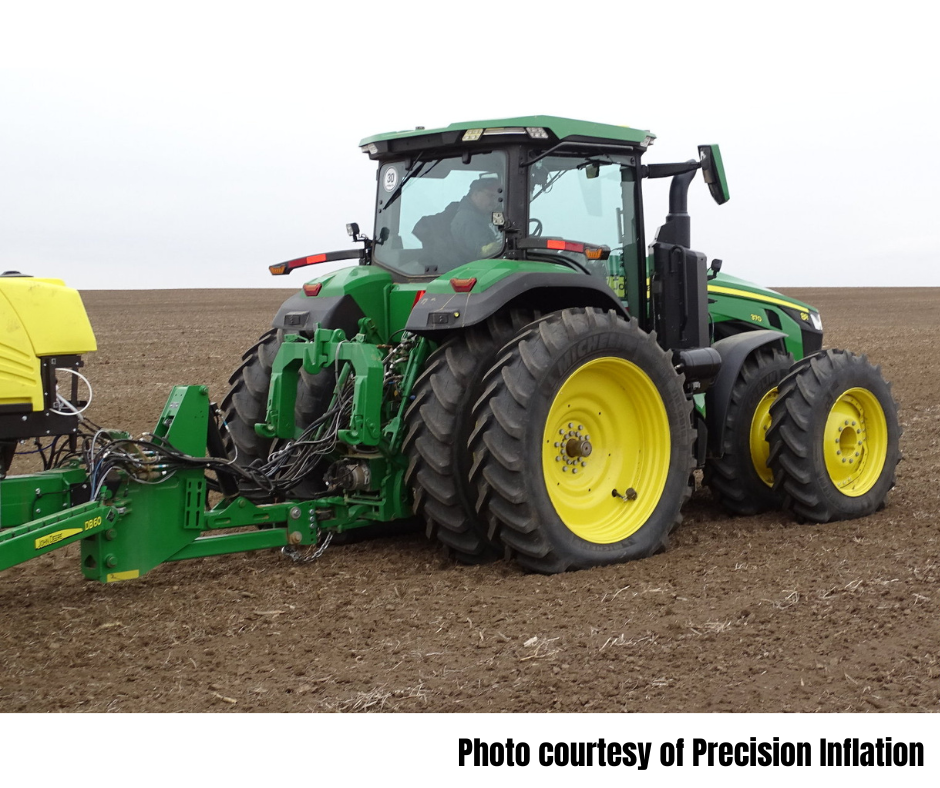AG TIRE TALK KEY TAKEAWAYS
MICHELIN: “In my experience, almost 9 times out of 10, producers are very reluctant to reduce their Ag tire pressures to recommended, single digit, operational pressures. In most cases, I believe this is due to their historic experience running higher pressures, or even the maximum pressure stamped on the sidewall of the tire.”
PRESSURE PRO: “I believe that producers are hesitant to run AG tires at the recommended single-digit PSI for fear that they’ll cause damage to the tire if driven on improved roadways while the pressure is set low.”
MAXAM: “Ag tires need to operate at the lowest air pressure possible to reduce the effect of the machine weight on the soil, decreasing the ground pressure and soil compaction…improving growers’ yields.”
FIRESTONE: “Traction and flotation are optimized by operating any given tire at the lowest possible inflation pressure that still enables it to carry the load it will be subjected to. If that pressure is in the single digits, then it is often a pretty good indication the tires are delivering a footprint that will provide exceptional traction and flotation. If the pressure required to carry the load is not in the single digits, then that may indicate an opportunity for additional improvement.”
TRELLEBORG: “As we reduce air pressure the footprint increases not only in width but also in LENGTH.”
BKT: “There are also perils to running low inflation pressures in the field and once out of the field. 9 psi in the field at 5-10 mph does not equal 9 psi on the road at 30 mph. Once out of the field and on the road, air pressures must be increased to handle the weight at road speed.”
PRECISION INFLATION: “Can the operator MAINTAIN the minimum psi? The answer is NO, unless they adjust the pressure for temperature, speed and axle load changes at every field and road change using a Central Tire Inflation System!”
YOKOHAMA: “Inflation pressures on our VF tires start at 12 psi, which is consistent with the Tire and Rim Association (TRA) load tables. TRA only recommends going into the single digits, a minimum of 6 psi, on dual or triple configurations.”
DORAN: “Producers can be confident their tires are at the correct inflation pressure as our TPMS is accurate within +/- 1 PSI.”
All information is provided in this blog solely to provoke thought. All deductions made from information on this site must be confirmed by Certified Ag Tire Dealer & Tire Manufacturer before use. Ag Tire Talk does not recommend anyone conduct tire service work with exception of Certified Ag Tire Dealer Professionals.
Michelin Ag
David Graden: Operational Market Manager – Agriculture
In my experience, almost 9 times out of 10, producers are very reluctant to reduce their Ag tire pressures to recommended, single digit, operational pressures. In most cases, I believe this is due to their historic experience running higher pressures, or even the maximum pressure stamped on the sidewall of the tire.
Why run at Low PSI?
When we recommend single digit pressures to producers, we always have to begin with the ‘why’ behind our recommendation. I could easily spend an hour on this topic; however, the key points are: Improved Traction due to a larger footprint and more lugs on the ground, which significantly improves floatation, then reduced soil compaction, then better crop yield and improved fuel economy and finally an overall improvement in efficiency and added money to your bottom line.
When to run Low PSI?
Unfortunately, it isn’t as easy as simply reducing your tire pressure until you see 3 lugs on the ground, either. How do we reach that single digit recommendation? Well, to begin, the producer’s tires must fit the application. Is the machined strictly confined to field use, does it travel over the road and how much, are the tires under significant torque, is the machine’s weight properly distributed to transfer the necessary torque for the application, etc?
Standard Tire/No CTIS High Pressure
Let’s look at an example using a John Deere 8R 410 Tractor, pulling 24 Row Fold Up Planter.
Without CTIS & VF Tire Construction, pressure must be set to highest speed (30 mph road) and highest load (planter in folded position) for all applications as shown below:
Rear: 26 PSI
Front: 23 PSI
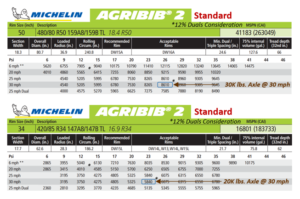
VF/CTIS PSI Low Pressure
With CTIS & VF Construction pressure can be set to lowest field speed (10 mph plant) and lowest load (planter unfolded) as shown below:
Rear: 7 PSI
Front: 6 PSI
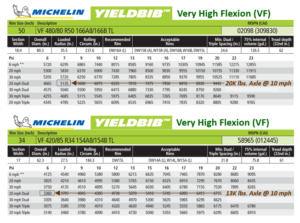
VF Tire Technology
Due to the flexibility and construction of the sidewalls, VF Tires can carry same load at up to 40% less air pressure vs a Standard Tire.
CTIS
Add a Central Tire Inflation System, and now you can run field pressures in the single digits, airing up to double digits on the road.
Always discuss air pressure recommendations with your local Michelin Ag representative to make sure they will work in your application before use, and to make sure all technical advisement is followed, such as adding 6psi when operating on steep slopes > 20%.
Each of our sales reps carries a set of scales in his/her truck, and each is specifically trained in calculating air pressure recommendations, proper weight distribution, ballasting, etc. at no additional costs.
Firestone Ag
Austin Fischer: Firestone Ag Field Engineer
Q1: Why are producers hesitant to run ag tires at recommended single-digit PSIs?
I think there are two key reasons producers are hesitant to run ag tires at single digit PSIs. First, single digit PSIs require growers to be more diligent about checking pressures, given the reduced margin for error. For example, if a farmer runs six PSI and loses one PSI, that equates to a loss of 17% of the inflation pressure. But if they run 35 PSI and lose one, the percentage lost is much smaller at only 3%.
The second reason some producers may be hesitant to run ag tires at single digit PSIs is that it becomes even more critical that they know the actual maximum axle loads that the tires will be subjected to. As discussed above, the margin for error is reduced significantly at single-digit inflation pressures, so one needs to be sure the tire can handle the load(s) it will see in service at that low of an inflation pressure. Growers must consequently be really dialed in on how much their base machines weigh as well as the weight added by implements, weight packages, aftermarket attachments, etc.
Q2: What is required to run ag tires at recommended single-digit PSIs?
To run farm tires at recommended single-digit PSIs, growers must know their maximum axle loads and the inflation pressures that their tires require to carry those loads. It’s also critical to diligently monitor tire pressure when running ag tires on single digit PSIs, as they can’t just be set and left alone.
Firestone Ag recommends checking tires at least once per day, perhaps in the morning while allowing the machine to warm up. We also suggest using an accurate, high-quality air pressure gauge that has been calibrated and is no more than 15 years old. Other tools that can help growers include a tire pressure monitoring system (TPMS), which automatically alerts operators when pressure drops below recommended levels, and a central tire inflation system (CTIS) to help keep tires in the appropriate pressure range.
Finally, growers need to make sure their tires and rims are in good shape. If tires are weather checked or worn down to 20% or less, they should be replaced. If rims are rusty or damaged, consider replacing them before trying to run tires on single digit PSIs.
Q3: What are some precautions for operating equipment with single digit PSIs?
It is imperative for producers to know their maximum axle loads and to be familiar with their tires’ load-inflation tables. They must have a firm grasp of both these details before they can pursue single-digit inflation pressures. Additionally, growers must be committed to diligently checking the inflation pressures and overall conditions of the tires at least every day. If they are not sure whether this is something they will be able to do, then it may be best to run a few extra psi over the minimum amount required to carry the load. For those unsure of how to determine the correct PSI for their load, reach out on the Firestone hotline 1-844-85-TIRES or visit a local dealer.
Another precaution is to be cognizant of the terrain on which the tires will be operating. If the tires will be operating in very hilly terrain, then we would recommend running 4-6 PSI over the minimum pressure required to carry the load to increase lateral stability. This is especially important if the tires in question are IF- or VF-designated, due to the increased deflection inherent with those designs of tires.
Lastly, we recommend that growers ensure their tires are fully seated on the rims. This can be done by visually confirming that the tire beads are fully against the vertical portion of the rim flange and concentric with the rim. If a tire is not fully seated on the rim, its beads could potentially unseat during operation.
Q4: How are traction and flotation improved by using single digit PSIs?
Traction and flotation are optimized by operating any given tire at the lowest possible inflation pressure that still enables it to carry the load it will be subjected to. If that pressure is in the single digits, then it is often a pretty good indication the tires are delivering a footprint that will provide exceptional traction and flotation. If the pressure required to carry the load is not in the single digits, then that may indicate an opportunity for additional improvement.
This improvement could be realized by upgrading to an IF- or VF-designated product, increasing tire size (width and/or height), removing unnecessary ballast, adding duals or triples, or any combination thereof. However, the one thing to note for growers seeking to run single-digit inflation pressures, is that there are industry-standardized minimum permissible inflation pressures for agricultural tires. This may result in the grower having to run more inflation in the tires than would otherwise be needed, thus diminishing the benefit of upgrading tires in the first place. As such, we would recommend growers who are already able to run close to single digits reach out to Firestone Ag’s Field Engineering team prior to making any major decisions and for further questions and assistance at 1-800-847-3364.
Trelleborg Wheel Systems
Chris Neidert: Marketing, Training and Development Manager – AG
Air pressure, what a subject that is constantly discussed and usually neglected in the ag world. Running single digit air pressures are also a hot topic so let’s discuss.
Let’s go over some basic instructions when trying to determine your tires air pressure. The tractor must be first ballasted correctly, meaning the total weight of the tractor necessary to transfer the tractor engine output torque with high efficiency to the ground (this can be discussed in another article). The weight distribution must then be determined meaning how much weight should be over the front axle and how much weight should be over the rear axle (this will be discussed in another article).
When the above conditions have been met you can then consult the tire manufacturers load table. Find the load table for that particular tire size. So if you’re using tire brand A, you must use the load table from tire manufacturer A to determine the air pressure and it is not recommended to use a load table from a different tire manufacturer as nominal conditions and load capacities could vary between manufacturers.
When choosing to run single digit air pressures, some tire effects need to be taken into consideration.
Let’s take as example a tractor running a particular size tire which is an 800/70R38. Tire load is 9,261 lbs. Here are the suggested air pressures from the tire manufacturers load tables for this tire size for the above load at 5 mph:

Below are images from varying air pressures with this tire size and load. These are pictures from load cell plates which detect pressure on the ground. You can see as expected as we reduce the air pressure the footprint increases not only in width but also in length.
Our first picture is showing the footprint image running 18 psi. This is typically what happens when producers look at the tire and see the sidewall bulging. This budging is due to the radial construction and the tire is designed for it. The producer doesn’t like the LOOK of the tire and will add air, putting it into to an over-inflated condition.
Our second picture is showing the image with 12 psi. The footprint gets larger and wider with a better load distribution with less pressure hot spots (red and yellow areas), that were depicted in the 18 psi picture.
Our third picture is the tire image running at 6 psi. Although the data from the load table is reading 6 psi as acceptable for that load, you need to see what happens to the footprint. The footprint gets also larger and wider, but we start to lose some contact area in the middle of the footprint. This is due to the low air pressure now enabling the tread face to actually lift up off the ground and reduce the contact area. You can also see the lug edges now start to have some pressure increase depicted by the greenish edges starting to develop.
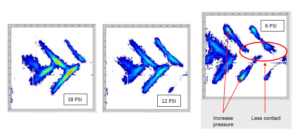
Also another point to consider at these ultra low inflation pressures, is to avoid the situation shown below. Here you see the same tire at 6 psi, which according to the tire manufacturers load table, was enough to carry the load passing over a piece of wood simulating a boulder in the ground during field operation. It is very clear the large sidewall deformation that happens and possible damage to the tire, rim or both, reducing the life of the assembly. This situation could also lead to potential air pressure loss due to lower tire bead pressure against the rim flange.
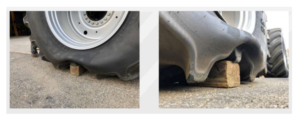
Something to keep also in mind – not every farmer has a precision measuring gauge handy and controls the inflation pressure on a regular basis. A measure variation of 2 psi at 6 psi could mean the tire ‘real’ inflation pressure could be at 4 psi or 8 psi. At 12 psi, measure variation of 2 psi could mean a range from 10 to 14 psi. 4 psi would be below the tire capability and would unseat the bead very easily – damaging the assembly.
According to the TRA manual if you are running single applications using IF or VF tires the minimum recommended air pressure is 12 PSI. We like to follow this technical recommendation for any tire situation and do not go below 12 psi of inflation pressure based on the situations explained before.
Let’s do a sample air pressure calculation for the below tractor set-up. We will do two calculations, one for using standard tires and one using VF tires.
- JD 7R 210 base weight = 22,200 lbs.
- Weight split = 40% front 60% rear
- Single Application
Standard tires
420/85R34 Front
Load per tire = 8,800/2 = 4,440 per tire
Suggested air pressure @ mph LT = 11 psi
480/80R50 Rear
Load per tire = 13,320/2 = 6,660 per tire
Suggested air pressure @ 5 mph LT = 11 psi
VF tires
VF420/85R34 Front
Load per tire = 8,800/2 = 4,440 per tire
Suggested air pressure @ 5 mph LT = 7 psi
VF480/80R50 Rear
Load per tire = 13,320/2 = 6,660 per tire
Suggested air pressure @ 5 mph LT = 7 psi
In our example with VF tires, we would recommend 12 psi per the TRA single application minimum air pressure recommendation.
So when considering single digit air pressures, we strongly recommend consulting the tire manufacturer for advice.
Yokohama Off-Highway Tires America, Inc.
Blaine Cox: National Product Manager—Agriculture, Golf and Turf
Inflation pressures on our Alliance Agriflex+ VF tires start at 12 psi, which is consistent with the Tire and Rim Association (TRA) load tables. TRA only recommends going into the single digits, a minimum of 6 psi, on dual or triple configurations. Even with those setups, farmers are wise to be hesitant—with such low inflation pressures, you are stressing your tires dramatically. It’s like redlining your tractor.
Remember that manufacturers design every aspect of a tire to perform within the bounds you see on the load and inflation table—how much movement you will experience in the sidewalls, how the bead performs, how much heat will be generated by the movement of the tire, and the shape of the footprint, among other factors.
Below-spec inflation pressure can create excess heat, apply stress to parts of the sidewall and under-tread that it is not built to handle, and cause other problems. Tires also rely on inflation pressure to maintain the bead’s lock on the rim. Too little pressure could allow the tire to fall off the rim, especially if it is being operated on a sidehill. Your load carrying capacity and top speed should always be within the bounds of the load and inflation table, noting special applications like steep slope air pressure increase adjustments.
Doran Manufacturing
Ross Ormsby: Director of Project Management
“Producers can be confident their tires are at the correct inflation pressure with Doran 360AG TPMS, the only system on the market that is accurate within +/- 1 PSI.”
BKT USA, Inc.
Dave Paulk: Manager Field Technical Services
Today’s ag radials are made to run at higher deflections and lower air pressures. Lower air pressures reduce ground bearing pressure and soil compaction. With lower air pressures, the tire has a wider and a longer footprint to spread out the weight of the tractor over a larger contact area. The ability to run lower air pressures in the field is a definite advantage to taking care of the ground and increasing traction and flotation. The wider and flatter the footprint of the tire, the better the traction and stability. There are also perils to running low inflation pressures in the field and once out of the field.
Modern tire construction has been improved to allow low pressures with the production of IF and VF technology. An IF rated tire can carry 20% more weight at the same air pressure as a standard tire, or conversely can run about 20% less air pressure and carry the same weight as a standard tire. A VF rated tire can carry 40% more weight at the same air pressure as a standard tire, and the same weight as a standard at about 40% less air pressure.
An example is the 380/90R46 159 A8/B versus the VF380/90R46 175D. The standard 380/90R46 will carry 7,260 lbs. at 35 psi at 30 mph. The VF version will carry that weight at 23 psi at 30 mph. At 30 mph, the VF is rated to carry 9,890 lbs. at 35 psi. This example shows the difference between load carrying capacity at the same air pressures versus reduced air pressures.
A tire must have the correct amount of air pressure to carry the weight of the tractor and implement. It is always best to prepare for the worst-case scenario. A tractor tire running at single digit air pressures at a field speed of 5-10 mph may be able to carry that weight, but as speed increases, the weight carrying capacity of a tire decreases. 9 psi in the field at 5-10 mph does not equal 9 psi on the road at 30 mph. Once out of the field and on the road, air pressures must be increased to handle the weight at road speed. On the road, higher air pressures are needed for higher speeds and lower rolling resistance (equals fuel savings). In the field, lower air pressures can be used for lower speeds and wider footprints (more traction, less compaction). Air pressures that are too low will cause an overload condition and destroy the sidewalls of the tire.
The size of the implements and the application can also determine how much air pressure should be used. Lower air pressures can generally be used in the field when the implement is hooked to the drawbar. The full weight of the implement (seeder, cultivator, etc.) is not on the tractor. In some areas, 16 row planters are used on the 3-point hitch. While the planters are on the ground, air pressures can be low. When the planters are picked up at the end of the row, all the weight is on the back of the tractor and air pressures need to be higher. This is an example where the worst-case scenario needs to be used. The air pressures should be set to handle the planter when they are in the air. Duals work best in situations where there is a lot of weight on the rear of the tractor due to heavy drawbar weight or use of the 3-point hitch. With duals, air pressures can be further reduced than if singles are used. Duals may also be needed to carry the heavy weight.
Farming on hillsides and slopes require higher air pressures even though they may not be needed to carry the weight of the tractor and implement. Running lower air pressures on hillsides can buckle the sidewall of the tires because of weight shifts from one side to the other. Hillsides and slopes are not the application to run single digit air pressures.
CTIS (Central Air Inflation System) are now being used in some instances. Many equipment manufacturers are looking at these systems because of the time tractors are used on the road to travel between fields. With a CTIS system, pressures can be dropped low in the field and the tires can be aired back up for transport between fields. If a CTIS system is not being used on a tractor, the air pressures should be set higher to handle the road speeds (worst case) although they may not need to be that high for the field. A producer can save money and downtime by planning for the heaviest loads they will carry and speeds. Tires and service are too expensive to constantly replace tires. Ag tires are built to withstand a lot of abuse, but they can only take so much. Low air pressures in the wrong conditions can cause the sidewall to flex too much and the tire will eventually fail.
Low air pressures can be used to the producer’s advantage in many areas. As stated, traction and flotation are increased by making the footprint of the tire wider and longer. This spreads out the weight of the tractor and implement. Soil compaction is decreased as air pressure directly effects soil compaction. Overall, the worst-case scenario should be considered when setting air pressures to protect your investment.
Pressure Pro
Jason Zaroor: President/CEO
I believe that producers are hesitant to run AG tires at the recommended single-digit PSI for fear that they’ll cause damage to the tire if driven on improved roadways while the pressure is set low. The ideal situation would be able to keep the tires at the single-digit level when working the soil, but then increase the tire pressure before traveling over improved roadways. If Ag tires with low air pressures are then driven on improved surfaces, it can cause a lot of damage to the tread and sidewall in a relatively short amount of time. For this reason, producers sometimes choose to run elevated air pressures even while working the soil, which can cause over-compaction and necessitate additional tilling.
Maxam Tire International
Greg W. Gilland: Business Development & Ag Segment Manager
Agricultural tires in comparison to construction, commercial truck, and passenger or light truck tires operate at the lowest air pressure possible. The primary reason agricultural tires can operate at such low pressures is the combination of the size of the air chamber in an ag tire and the number of tires mounted on a vehicle allowing lower air pressures to be able to carry the weight. The secondary reason that ag tires need to operate at the lowest air pressure possible is to reduce the effect of the machine weight on the soil. By decreasing the ground pressure and soil compaction. Agricultural tires operating at the best possible pressure have a direct impact on crop production and can improve farmers’ and growers’ yields.
On average agricultural tires tend to operate between 12-20 psi on tractors working in the field. The advent of IF (Increased Flexion) and VF (Very Increased Flexion) technology is allowing tire air pressures to achieve much lower pressure down to 9 psi. The structural capability of tires impacts how much air pressure is required to carry the intended axle load:
- Radial tire casing construction carries 20% of the axle load while the pressurized air in the chamber carries the remaining 80%.
- Bias tire casing construction carries 40% of the axle load while the pressurized air in the chamber carries the remaining 60%
As technology continues to evolve with radial tires, especially with VF tires the ability to operate continuously at a working air pressure of 9 psi has become a commercial reality. Below are visual examples of the effect of air pressure, tire casing flexion, and tire footprint (gross flat plate) on standard, IF, or VF tires:

Fundamentally, VF Technology allows farmers to significantly lower air pressure without compromising the carrying capacity of the tire. This results in a much longer tire footprint or gross flat plate that spreads the weight of axle over a larger area which significantly reduces the ground pressure effect and lowers soil compaction improving the producer’s crop yield. Listed below are the advantages of VF Tire solutions that can operate at low air inflation pressures:
- Tire construction is sturdier and designed to be very flexible without compromising casing endurance or tire life.
- Greater load carrying or axle load capacity, if necessary, by adjusting the air pressure as needed
- When operated at -40% air inflation pressures, VF tires will reduce soil compaction improving crop yields due to the larger tire footprint and increased flotation over the soil resulting in lower ground pressure.
- VF Tires are designed to operate safely with a higher heat resistance of the casing despite -40% lower air pressure on the road or in the field.
- VF Tires have a long footprint when operating at -40% air inflation increasing tire contact patch or flotation, traction, and reducing tire slip.
- Lower air pressures also improve ride and have a greater contact patch (flotation) improving overall machine stability on the road or in the field.
- VF tire pressures when operating at -40% air inflation in fact enhance both traction and stability when on sloped or steep fields.
With all the above technological reasons that should convince or drive producers to convert to IF or VF Tires, below are the primary reasons producers hesitate to operate at these pressures:
- The perception that the tires operating at low pressure (9 psi) are too low or look flat.
- Concern when having to transport (road) the machinery that lower air pressures will slow the equipment or consume more fuel.
- The perception that low air pressure could lead to a tire flat in a remote area.
- Historically perceived comfort for operating at 16-18 psi as the lowest threshold of air inflation in the field.
- Concern that they must continuously adjust air pressures up or down which is time-consuming when changing equipment based on expected axle loads (heavier or lighter).
- Producers are comfortable with operating at one set inflation pressure that addresses all their equipment or load variables.
In the European market, tractors not only do the work in the field but are also used to transport the crops or equipment over highways and roads at higher speeds than in other markets. This growing global need or market demand to operate at higher road speeds than in the field has necessitated equipment solutions to meet this requirement and overcome the above perceptions allowing the adoption of modern technologies such as IF or VF tire construction to improve operational results:
- Weighing the tractor or vehicle to set the fieldwork air pressure based on the highest weight implement and define an alternative higher air pressure for the same load when roading or transporting the tractor or vehicle = time tried mechanical but slow solution delivering a reliable practice that is time-consuming.
- Use of air pressure monitoring systems in the tractor or vehicle controls allowing for the stoppage of the equipment and manual adjustment to higher air pressures for the roading or transport part of the workday based on known or weighed axle loads= effective and accurate system providing the current state of tires and allowing for the adjustment of air inflation pressures but still very time-consuming.
- Adopting CTIS or centrally operated tire inflation systems, a purposely built onboard air pressure adjustment system that is connected to the tires and operated from the tractor or vehicle cab. The CTIS-type systems allow for immediate adjustment up or down of the tire inflation to accommodate for the fieldwork or transport (roading) air pressure requirements. Producers can instantly adjust the air to either accommodate for tire footprint needs lower air for a longer footprint for reduced soil compaction or increased air pressure for higher transport speeds = the most effective and time-reducing solution if at a higher initial acquisition price on a new or retrofitted vehicle
MAXAM VF tires are designed for either heavy load and high pressures (+40% Load) or lower air pressures for a given load (-40% air pressure); when used at higher pressures the tire casing will not be subjected to excessive flexing which ensures more durable or longer casing life. Producers need to adopt tire solutions that meet their operational and value needs. Each operation, crop, or soil condition will determine the type or size of equipment to be utilized. In each instance, producers have an opportunity to define and choose what technology or solutions best suit their operational requirements to achieve their operational objectives.
Precision Inflation Systems
Ken Brodbeck: VP of Technology
That depends if you adjust tire pressure by hand or automatically in the cab.
With high performance IF and VF radial tires, farmers have the ability to run single digit pressures per the load/inflation charts. See below:
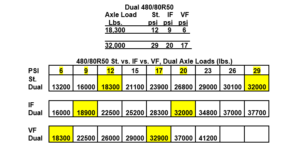
The better question is, can the operator MAINTAIN the minimum psi? The answer is NO, unless they adjust the pressure for temperature, speed and axle load changes at every field and road change!
If farmers cannot maintain proper pressures, then they need to add 3 to 5 psi for a SAFETY MARGIN. Essentially knocking a VF tire back to an IF or even standard tire pressure level.
One major OEM tractor price sheet, going from STANDARD to VF 480/80R50 and matching front dual option is a $ 22,900 upcharge.
A complete front and rear axle Central Tire Inflation System for 8 tires plus hydraulically powered air compressor is less than $ 20,000.
Other CTIS advantages:
- 2 to 4% higher yields by reducing or eliminating pinch row compaction
- 5 to 10% better fuel economy on both field and road
- Better handling on road with firm tire sidewalls
- 15 to 20% longer tire life, by raising low VF and IF tire psi for road transport
- Cooler running tires with heavy hitch tool bars and front fold planters
- Add extra 3 psi for hills and side slopes if necessary
- CTIS allows farmers to optimize the performance of their equipment on the road and in the field while protecting their tire investment
- CTIS is crucial to protecting soil health by significantly reducing compaction
Without CTIS most ag tire engineers recommend adding 3 to 4 psi above the minimum listed to maintain minimum pressure with temperature changes. Remember, for every 10 degrees F change = 1 psi change in the tire.
So if tires are set when the temperature is 80 F and the temperature drops to 40 F, you lose 4 psi in the tires. They are now underinflated and prone to damage. Therefore, many tire dealers over inflate tires to be SAFE. No one wants to tell the farmer he did not have enough air in the tire and VOID the warranty.
Without CTIS, Pressure is just a GUESS!
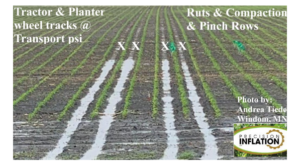
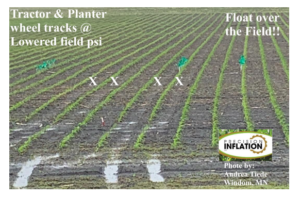
All information is provided in this blog solely to provoke thought. All deductions made from information on this site must be confirmed by Certified Ag Tire Dealer & Tire Manufacturer before use. Ag Tire Talk does not recommend anyone conduct tire service work with exception of Certified Ag Tire Dealer Professionals.

